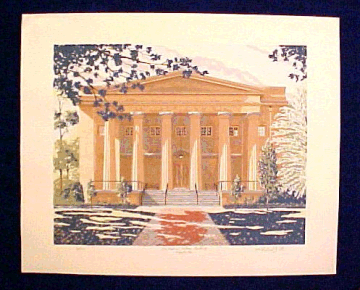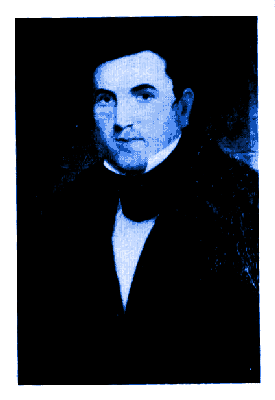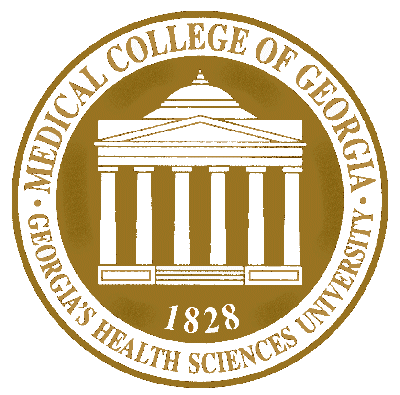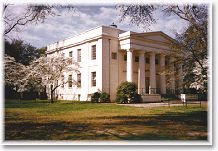
History of
The Medical College of Georgia
Augusta, Georgia

The Old Medical College of Georgia Building
On Telfair Street, Augusta, Georgia

A Brief History of MCG

Dr. Milton Antony, 1789-1839
Chief Founder, Medical College of Georgia
In the early 1800's, most physicians in America had no formal degrees. Instead, they trained as apprentices for a few years to learn their trade. There were fewer than 100 physicians in Georgia. As the number of medical schools in the U.S. increased, so did the number of Georgia physicians with degrees.
In 1822, several Augusta area physicians organized the Medical Society of Augusta. They apparently hoped to start a school in Augusta, but no formal plans were drawn up by this group.
In 1826 Dr. Milton Antony, a leader in local medical circles, began to teach apprentices in two borrowed rooms of the City Hospital (opened in 1818). Dr. Antony had trained under the preceptor system, attending only one formal course of lectures at the University of Pennsylvania. He was unable to return for the second required term because of finances and so did not receive his degree. After about fifteen years of active practice in Georgia and Louisiana, he received his M.D. "ad eundum" in 1825 from the Medical College of South Carolina.
With strong local backing, Dr. Antony journeyed to Milledgeville, then the state capital, seeking a charter. The Medical Academy of Georgia was chartered by the State in an act that was signed into law on December 20, 1828, by then-Governor John Forsyth of Augusta.
The first class at the Academy began on October 1, 1829, in rooms of the City Hospital that had been renovated and equipped by the faculty at a cost of $457.13. There were seven students at that first session.
On December 19, 1829, the General Assembly authorized the school to grant the M.D. degree and changed the name to the Medical Institute of Georgia. The first formal commencement was held on April 7, 1833, with four graduates. It was also in 1833 that the school received its present name, the Medical College of Georgia. It was with this name that the first diplomas were engraved and awarded.
In 1834 construction of the stately Medical College building on Telfair Street was begun. The legislature, pleased with the progress of the school in Augusta, appropriated $10,000, along with 50 lots on the town common of Augusta to be sold, the proceeds to be paid over to the College. The city gave $5,000, in return for medical care for the city's prisoners and the poor at City Hospital. The remarkable domed building was occupied in 1835, completed in 1836, and served as the main teaching facility for the school until the end of 1912.

In January of 1913, the school moved to larger quarters in the Newton Building some distance away. The original Medical College of Georgia building, still standing today, has come to symbolize the entire institution.
The school grew and by the 1850s classes were large and well-attended--right up until December 20, 1860, when South Carolina seceded from the Union. Georgia took the same course on January 19, 1861. During the war the school was closed, and the Medical College building itself was converted into a military hospital.
MCG next held classes on November 6, 1865, with 47 students attending, including 3 Yankee soldiers. The first post-war commencement was held on February 24, 1866, with 9 students receiving degrees. It is a tribute to the strength and fortitude of the faculty of the College that they were able to reopen at all in the misery and deprivation of the post-war South.
On July 5, 1873, following negotiations, a loose agreement was struck between the Medical College of Georgia and the University of Georgia in Athens. From 1873 to 1950 the school was called "The Medical College of Georgia, being the Medical Department of the University of Georgia."
The first extant record of alumni organization was in 1891, when 15 alumni met to formally elect officers.
MCG received a "class A" rating in 1907, but medical education was generally in a sorry state in the early 1900s. In 1910 Abraham Flexner published a scathing report that struck death blows to many proprietary medical schools. He recommend the immediate closing of the Medical College of Georgia. The faculty and the legislature acted quickly to bring MCG up to national standards. Unfortunately, the following 20 years saw a steady decline in the quality of operation of the Medical Department.
In 1931 the dean resigned and many faculty followed. The Depression and Politics were in charge, not the educators. In 1833 the Board of Regents voted to close the Medical College. A storm of support failed to move the legislature until Mr. Roy V. Harris, Augusta legislator and long-time Speaker of the House of Representatives, managed to convince Governor Eugene Talmadge to change his vote on the Board of Regents. The other Regents soon saw the light and the school survived.
Nevertheless, in 1934 the AMA dropped the school from its "class A" list. In 1934 Dr. G. Lombard Kelly was named Dean and a massive program was undertaken to revitalize the College. Under his wise and vibrant leadership and with a strong base of support, the school returned to "class A" status in 1936.
World War II increased the demand for physicians, and brought a number of non-Georgians to Augusta. In 1945 the legislature authorized the construction of a badly needed new teaching hospital. Recognizing the difficulties involved in running a growing medical institution and a major hospital from Athens, leaders granted independent university status within the University System of Georgia in 1950. The traditional name, Medical College of Georgia, was restored to the 122-year-old school. Dr. Kelly was named the first President of MCG.
The new teaching hospital, Eugene Talmadge Memorial Hospital, opened in 1956, again in large part due to the efforts of Roy Harris in the General Assembly.
The early 1950s marked the emergence of MCG as a health sciences university. The nursing program begin in 1894 had evolved into a local hospital nursing school. In 1956 it merged with a nursing program at the University of Georgia, and became the School of Nursing. The medical technology program, in operation since 1937, became a baccalaureate program in 1955. A medical illustration program initiated in 1949 awarded its first M.S. degree in 1951.
Radiologic technology and medical record administration programs were established in 1962. Ph.D. programs were begun in 1963, which led to the establishment of a School of Graduate Studies in 1966. A School of Dentistry was approved in 1965, accepted its first students in 1969, and graduated its first DMDs in 1973.
An associated dental sciences program was started in 1967. The School of Allied Health Sciences combined this program with other disciplines in 1968, and grew to include nine major disciplines. A master of science in nursing program was started in 1968. Programs in physical therapy, occupational therapy, and respiratory therapy followed. A master of health education in many of these disciplines was approved in 1974.
The physical plant grew to include dozens of state-of-the-art facilities. It is difficult to believe that the very existence of this medical university was threatened so many times during its first 150 years. Despite its on-again off-again administrative relationship with the University of Georgia, a steady stream of UGA students have passed through MCG, creating a dual alumni loyalty that remains strong and unbreakable today.

The Infinity Logo of MCG

The logo used by the Medical College of Georgia during its sesquicentennial period was designed as a variation of the universal infinity symbol. It represents the constant battle to save and enhance life that is being waged by all of the health professions. It resembles a flower blossom, another symbol of the promise of healthy life. The intricate intertwining floret includes five "petals." Each represents one of the five schools of MCG: Medicine, Dentistry, Nursing, Graduate Studies, and Allied Health Sciences.


This website is not an official or approved site of
the Medical College of Georgia, Augusta


The Medical College of Georgia Collection

Home





